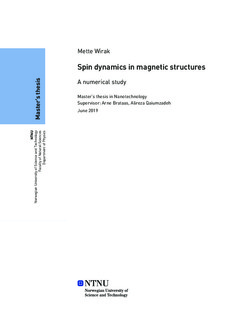| dc.description.abstract | Spintronikk foreslår en alterativ måte å gjøre datalagring på, som vil kunne være både mer effektiv og raskere. Grunnlaget for forskningsfeltet er den kvantemekaniske egenskapen spinn, som gjennom spinnbølger kan forflyttes uten at partiklene selv flyttes på. Denne masteroppgaven ser nærmere på bevegelse av magnetiske strukturer - spesifikt domenevegger og skyrmioner - forårsaket av spinnbølger.
Det analytiske arbeidet baseres på å behandle atomisk spinn som en klassisk vektor, hvor vekselvirkningene mellom spinnene inkluderer både klassiske og kvantemekaniske effekter. Ut ifra dette vil Landau-Lifshitz-Gilbert-ligningen bli utledet, som beskriver utviklingen i ordnede spinnsystemer. Denne blir videre kombinert med termodynamikk for å uttrykke den forventede hastigheten til antiferromagnetiske skyrmioner plassert i en temperaturgradient. I utledningen blir det lagt vekt på antagelser som gjøres, slik at uttrykket for hastighet forstås og kan adapteres til spinnbølger generert ved hjelp av andre krefter enn temperaturgradienter.
I mikromagnetiske simuleringer oppnås bevegelse av antiferromagnetiske skyrmioner, både ved en temperaturegradient og ved et lokalisert magnetisk felt. Førstnevnte gir bevegelse med høy variasjon, grunnet tilfelding termiske fluktuasjoner, og høyeste observerte gjennomsnittshastighet er på 8.9 m/s. Det lokale magnetfeltet er deterministisk og gir høyere hastighet, med høyeste gjennomsnittshastiget observert på 103.2 m/s. Ingen av metodene viste noen bevegelse av skyrmionene i y-retning.
Blant resultatene kan to trekkes frem som særlig viktige. Demonstrasjonen av bevegelse i antiferromagnetiske skyrmioner gjennom spinnbølger generert av lokaliserte magnetfelt sees, og er ikke vist numerisk tidligere, ifølge det forfatteren har funnet. Videre er mangelen av bevegelse i y-retning et viktig punkt, da dette avviker fra de analytiske beregninene. En temperaturgradient genererer spinnbølger med tilfeldig polarisering, hvilket i gjennomsnitt fører til null overført vinkelmoment og at skyrmionet forblir på samme sted i y. De magnetisk genererte spinnbølgene burde imidlertid gi forskjellige hastigheter i y, bestemt av polariseringen til det påsatte magnetiske feltet. | |
| dc.description.abstract | Spintronics, the fundament of this thesis, proposes a way of doing data storage more efficiently and faster. The field is based on the quantum mechanical property of spin, which can be transferred through spin waves without moving the particles themselves. This thesis will consider movement caused by spin waves of stable magnetic structures, specifically domain walls and skyrmions.
The analytical work is based on treating the atomic spins as classical vectors, using descriptions of both classical and quantum mechanical spin interactions. From this, the Landau-Lifshitz-Gilbert equation is derived, decribing the motion of an ordered spin system. This is subsequently combined with thermodynamical concepts, such as to give expressions for the expected antiferromagetic skyrmion velocity in a temperature gradient. Importance is here put on the assumptions made during the derivation, so that the result can be understood and adapted to also consider spin waves generated without the thermal gradient.
Running micromagnetic simulations, antiferromagnetic skyrmion motion is successfully obtained using both a temperature gradient and a localised magnetic field. The former gives skyrmion motion with a high variation, due to random thermal fluctuations, with a mean velcity of 8.9 m/s obtained at the highest. The localised magnetic field gives much higher skyrmion velocities, with the maximum mean velocity observed being 103.2 m/s, and is deterministic. Demonstrating that the localised magnetic field does give significant antiferromagnetic skyrmion motion is one of most important results of the thesis, as references of that being done in numerical simulations previously have not been found.
A further significant result is the lack of movement in the y-direction. Neither method produced any skyrmion motion perpendicular to the spin waves, which is not in accordance with the analytical predictions. The temperature gradient is prediced to give spin waves of random polarisation and thus no net transport of angular momentum, with the skyrmion maintaining a constant position in y. However, the magnetically induced spin waves are predicted to give differing velocities in y, as determined by the polarisation of the magnetic field applied. | |
